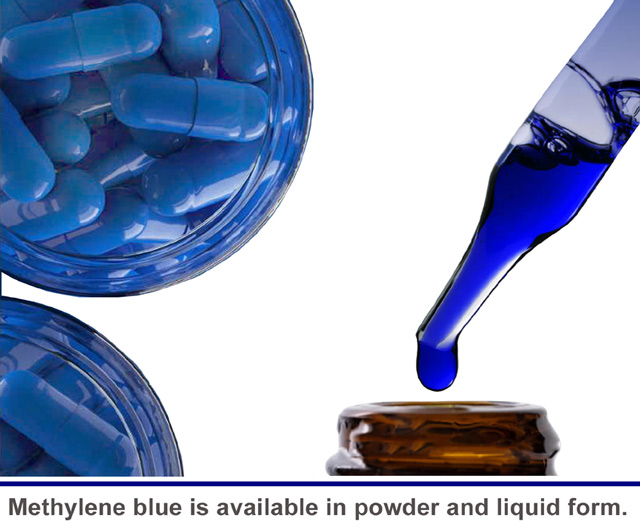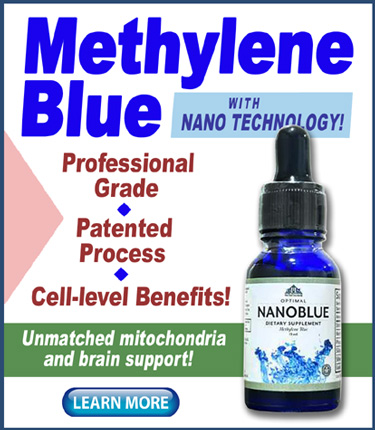In just a few months methylene blue will celebrate its 150th birthday.
Today the unique medicinal compound is known for promoting mitochondrial health, enhancing energy production and reducing oxidative stress; however, during its 150 birthdays it has experienced a much more diverse and fascinating history.
Methylene blue, or methylthioninium chloride, is a synthetic compound with a vibrant blue color. The process to synthesize it is quite complicated, and it contains various compounds, including carbon, chlorine, hydrogen, nitrogen, and sulfur.
In its natural state methylene blue is actually a solid crystalline powder. When it’s used for medical purposes, it is most often dissolved in a sterile liquid to create a solution, which is then typically injected.
Methylene blue was discovered—or first created—by German chemist Heinrich Caro in 1876. At the time Caro was working for the dye manufacturing company BASF, and he initially synthesized methylene blue as a textile dye to supplement the product line.
Synthetic dyes were a burgeoning industry in the late 19th century, but methylene blue differed from other creations of the era because it was soon discovered that its unique chemistry provided more than a brilliant blue coloring agent—it also possessed potent medicinal benefits.
From dye to medicine
The transition from textile dye to medicine evolved largely thanks to the groundbreaking work of other researchers.
The first medicinal application came a little over a decade after discovery when German physicians Paul Ehrlich and Paul Guttmann began testing the compound’s potential in treating malaria.
Ehrlich, who would later win a Nobel Prize for his work in immunology, had a theory that if the dye could selectively stain microorganisms like the malaria parasite without harming the surrounding human tissue, it could be used as a targeted treatment.
Research by the two physicians was published in 1891, and appears to be the onset of methylene blue’s use as a pharmaceutical medicine.
It should be noted that this occurred at a time when most “pharmaceuticals” were herb-based, and the idea of using chemical agents to treat disease was a new concept. So, methylene blue was ground-breaking in more ways than one.
Besides being the first synthetic compound to treat malaria, it was also the first synthetic compound to be used as an antiseptic.
As research and experimentation progressed, it was used to treat urinary tract infections and as an antidote for metabolic poisons such as cyanide and carbon monoxide.
Today methylene blue is still widely used as a hospital antiseptic around the world. It also remains on the World Health Organization’s Model List of Essential Medicines.
Because it has been used traditionally as an antidote for serious diseases, many countries, especially those with smaller economies, ensure that essential medications are available.
As a medication, in the U.S. methylene blue is mainly used to treat methemoglobinemia—a rare condition that affects the blood’s ability to transport oxygen. In fact, methylene blue remains the primary antidote for the condition.
Methylene blue can also be obtained for “off label use” from a compounding pharmacy if a doctor writes a prescription; however, since most physicians today know little to nothing about the compound, it’s not likely methylene blue will ever see the list of top-selling pharmaceuticals.
Introducing time-tested methylene blue updated with cutting edge nano technology!
NanoBlue
OHS has partnered and secured the rights to the only fully-patented organified methylene blue in existence.
Nano technology solves the historical challenges with poor absorption. This new technology includes:
• Gold nanoparticles that act as tiny electron donors, enhancing energy transfer inside cells and boosting antiviral activity.
• Silver nanoparticles that work with gold to disrupt viral replication and help protect cells from viral entry.
• Liposomal Delivery System that provides a natural fat-like bubble that protects the ingredients through digestion, ensuring rapid absorption and direct support at the cellular level.
Whether you’re fighting fatigue, supporting cognitive clarity, or strengthening resilience, NanoBlue was designed as a professional-grade solution you can feel confident using every day.
A small comeback
Notably, even though methylene blue fell out of favor in the treatment of malaria as more modern medicines came into use, it is now making a comeback on the malaria front.
The renewed interest is driven by a new and critical challenge in the fight against malaria: widespread drug resistance.
The malaria parasite, Plasmodium falciparum, has developed resistance to most of the modern antimalaria treatments. This has created a global health crisis, and scientists are urgently looking for new tools.
Besides providing a different mechanism of action, and low cost accessibility, it turns out that methylene blue can literally block transmission of the disease.
In one of the most exciting findings in recent years, methylene blue was shown to be highly effective at killing the parasite’s gametocytes, the stage of the parasite that can be picked up by a mosquito and transmitted to another person.
Research has shown that in as little as 48 hours, a patient treated with methylene blue can become non-infectious to mosquitoes, which is a major breakthrough in preventing the spread of the disease.
Growing recognition as nutritional supplement
Notwithstanding the modest malaria treatment comeback, it has limited “FDA permission” of use as a medicine in U.S.
While other countries might enjoy wide availability and the ability to treat all the conditions it has historically been used for, in the U.S. it is mostly limited to treatment of methemoglobinemia and as a marker dye for blood and lab testing.
Even with organizations such as Harvard Health listing some of the off-label uses, doctors who are educated on methylene blue benefits, and are willing to write off-label prescriptions, are few and far between.
In the nutritional supplementing world, however, it is a far different situation. Research is abundant, and numerous health-building applications are recognized.
How methylene blue improves cellular function
In normal cellular respiration, electrons derived from the foods eaten are passed through a series of protein complexes in the mitochondria (part of the cell involved in energy production).
This process ultimately leads to the production of ATP, the cell’s energy currency. In this process, oxygen serves as the final electron acceptor in this chain—the mitochondrial electron transport chain. And this is where methylene blue comes in to the picture.
Methylene blue has the unique ability to accept electrons and transfer them directly to oxygen. This shortcut effectively bypasses parts of the regular “electron transport chain.”
This unique biological shortcut enhances energy production, particularly in situations where normal cellular processes are impaired.
By facilitating more efficient electron transfer (and energy production), methylene blue improves various aspects of cellular function and overall health.
More than 29,000 research papers are listed on the U.S. government’s PubMed database relative to methylene blue.
Thousands of these documents include studies demonstrating positive results relative to a number of health challenges.
• Methylene blue has demonstrated neuroprotective properties that help support healthy brain function. Studies show supplementation can improve mood, memory, focus and fatigue. Preliminary studies also show it may lower the risk of Alzheimer’s and Parkinson’s disease.
• Other methylene blue studies have focused on the very medical benefits demonstrated in the past: antimicrobial, antiviral, anti-aging and anti-cancer benefits.
• In addition methylene blue has also been studied as a pain reducer. Research has shown that it can trigger various anti-inflammatory pathways and decrease the expression of pro-inflammatory proteins called cytokines.
For many people this decrease in inflammation provides a reduction in pain.
Another area of growing research is cellular energy. Studies show methylene blue has a significant effect on cell energy by interacting positively with the mitochondrial electron transport chain, which is crucial for generating energy in cells. (See the sidebar on this page to learn more about this cell energy process.)
Final word
With the original 1800s-era patent long-since expired, methylene blue is today manufactured worldwide. Pharmaceutical use remains the number one use, according to recent market data; however, this standing could change in the future as interest in methylene blue grows in other spheres.
Its versatility is seen in the wide variety of applications: nutritional supplement, dye, disenfectant, redox indicator, photosensitizer, water testing agent, biological staining compound, and aquaculture essential.
In aquaculture there are parallels to the historic use in humans. It is used by fish hobbyists as a treatment for fungal infections. Moreover, with the help of light, it is also effective against bacteria and viruses.
It is also used for treating fish infected with the parasitic protozoa Ichthyophthirius multifiliis in lieu of more toxic treatment options.
Like in humans, methylene blue is also used to treat methemoglobinemia—something that occurs due to nitrite poisoning. Also like humans, methylene blue helps treat cyanide poisoning in fish populations.
Quality concerns
The wide variety of uses highlights another critical aspect of methylene blue: quality and purity also vary widely.
Industrial grade is far different from human grade, or at least it should be. Even “human-grade” labels can be misleading since there can still be wide purity variation.
The safest bet when purchaseing methylene blue for supplementing is to look for products made to a 96%- 100% pure pharmaceutical-grade quality. It should be made in a GMP-certified facility that provides third-party purity testing with documentation.
Improved technologies
While it is true the chemical structure “methylene blue” cannot be patented, different manufacturing processes and technologies can be—and this has led to improvements in effectiveness and safety.
One such example is the use of new patented nanotechnology, which makes methylene blue molecules more stable. This stability improves absorption, cell penetration and energy production. (See sidebar panel for more info on this groudbreaking technology.)
The technology improvements are also spurring growth of methylene blue in the health and nutrition sphere.
It just may be that with research mounting, along with wider recognition of the health benefits, methylene blue is becoming a mainstay nutritional supplement for people endeavoring to take control of their own health.
– – –
For professional grade U.S.-manufactured methylene blue, check out Optimal NanoBlue from Optimal Health Systems.
– – –
Sources: PubMed.gov (methylene blue), HarvardHealth.edu, World Health Organization, Wikipedia sources: Methylene blue, Methemoglobinemia, Plasmodium falciparum.


